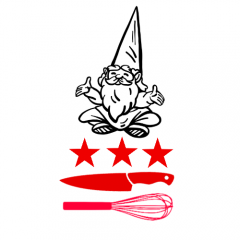 Ever since I purchased Ruhlman’s Charcuterie years ago I’ve wanted to make Spanish chorizo but it requires dextrose and meat starter culture, two ingredients I never had on hand and had always put off buying. That all changed last month when I decided this coming winter would be the winter of fermented sausage and ordered the necessary ingredients. Chorizo was top of the list as the first sausage to get made.
Ever since I purchased Ruhlman’s Charcuterie years ago I’ve wanted to make Spanish chorizo but it requires dextrose and meat starter culture, two ingredients I never had on hand and had always put off buying. That all changed last month when I decided this coming winter would be the winter of fermented sausage and ordered the necessary ingredients. Chorizo was top of the list as the first sausage to get made.
It turned out FRICKIN AWESOME!!!!
I know it gets old hearing this, but I honestly think this is the finest piece of charcuterie I’ve crafted so far. Seriously. It dried perfectly, has great color, taste, shape. Everything. I would put this up against anything you can buy in stores here and feel mine would win. Smoky spiciness from the pimenton, good garlic, it’s an excellent piece of charcuterie and a pretty basic one to start with.
Going into this curing season I wanted to experiment more with curing times to see how longer aging affects the end product. I know the longer you age things the better they should become but I wanted to see how they tasted. So I tested the chorizo.
According to Ruhlman, chorizo should be ready after 18-21 days of drying time. I sampled a length when the chorizo had lost 30% of its post-cure weight at about 2 weeks, then around the 25 day mark, and now at the 5 week mark.

The first was good but the color hadn’t developed as much as you see here and the chorizo was softer in the middle, more like a salami, and very tangy. At the 21 day mark, the color had developed and you could taste the pimenton a lot more, though still a bit on the tangy side. Now after about 5 weeks the chorizo has stiffened considerably and as you can see has excellent color, the tanginess has mellowed considerably, and more pimenton-y flavor including a nice bit of heat. Longer was definitely better in this case! So happy with the result, I can see myself making a lot of chorizo over the winter.
Speaking of the winter season, this year I’ve timed my initial batch of curing almost perfectly for the holidays. Bresaola is ready and came out of the fridge the other day (delicious), chorizo is ready, nduja is ready, coppa should be ready any day now, and there’s one more special new item I hope to have ready in another week or so. We’ve pretty much got our very own charcuterie platter we can bring to parties if we can keep ourselves from eating it all!
Now, where’d the manchego and wine go?
Spanish Chorizo
- 5 lbs pork shoulder, cubed
- 50 grams Kosher salt
- 1 tsp Insta Cure #2/DQ Curing Salt #2
- 10 grams Dextrose
- 15 grams Bactoferm F-RM-52 (starter culture)
- ¼ C distilled water
- 4 Tbs Spanish Pimenton (picante)
- 3 Tbs minced garlic
- 10 ft hog casings
Combine and mix the pork, salt, Curing Salt #2, pimenton, and garlic. Chill until ready to grind or set in refrigerator and chill overnight. When ready to grind mix in the dextrose.
Run water through the casings and let soak in a small bowl of water for 30 minutes or until you’re ready to stuff them.
Using the large holed grind plate, grind the seasoned pork into a mixing bowl set in ice.
Dissolve the starter culture (bactoferm) in the distilled water.
Add to the meat and mix well. Make sure it gets distributed throughout the meat. Use the stand mixer if possible for this step.
Stretch and push the hog casing onto the stuffer tube attachment, leaving an inch or two hanging off the end of the tube.
Stuff the sausage keeping one hand on the end of the tube where the casing is getting stuffed and help it along if it gets stuck.
Twist into 12 inch lengths.
Tie off in pairs with loops on the ends for hanging. Weigh the pairs and record.
Hang in your curing chamber ideally at less than 60°F with 70% humidity until the links are completely stiff or have lost 30% of their weight.
It should be between 18-21 days to lose that much weight but if you really want to dry them out to very stiff it will take around 28-35 days.

Jeeze looks spectacular! Salud!
Thanks!
What edition of Charcuterie did this recipe come from? Ruhlman seems to have changed his recipe for Spanish Chorizo. The 2013 version calls fornsmoked hot Spanish paprika, Ancho Chile powder, cayenne, and NO WINE. Thoughts? I’m inclined to follow this one.
Mine is a 2005 edition, it has those ingredients in the recipe. I am pretty sure I didn’t like the idea of ancho chiles and cayenne in a Spanish chorizo so I changed it. Came out great.